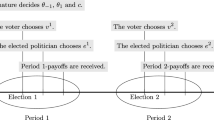Abstract
I develop a two period model of elections in which voters’ first period actions affect candidates’ estimates of voter preferences and thus affect second period electoral and policy outcomes. I find an equilibrium in which centrist voters abstain in the first election, despite facing zero costs of voting and having a strict preference between the alternatives before them. The reason centrists abstain is to signal their preferences to future candidates and thereby promote future policy moderation.
Similar content being viewed by others
References
Banks JS, Duggan J (2002) A multidimensional model of repeated elections. Caltech Typescript
Calvert RL (1985) Robustness of the multidimensional voting model: candidate motivations, uncertainty, and convergence. Am J Polit Sci 29:69–95
Conley PH (2001) Presidential mandates: how elections shape the national agenda. University of Chicago Press, Chicago
Feddersen TJ (1992) A voting model implying Duverger’s law and positive turnout. Am J Polit Sci 36:938–62
Feddersen TJ, Pesendorfer W (1996) The swing voter’s curse. Am Econ Rev 86:408–424
Feddersen TJ, Pesendorfer W (1999) Abstention in elections with asymmetric information and diverse preferences. Am Polit Sci Rev 93:381–398
Ledyard JO (1984) The pure theory of large two-candidate elections. Public Choice 44:7–41
Meirowitz A (2005) Polling games and information revelation in the Downsian framework. Game Econ Behav 51:464–469
Meirowitz A, Tucker JA (2005) Strategic voting and information transmission in sequential elections: run boris run. Princeton University Typescript, New Jersey
Myerson RB (1998) Population uncertainty and poisson games. Int J Game Theory 27:375–392
Myerson RB (2000) Large poisson games. J Econ Theory 94:7–45
Myerson RB, Weber RJ (1993) A theory of voting equilibria. Am Polit Sci Rev 87:102–114
Palfrey TR, Rosenthal H (1983) A strategic calculus of voting. Public Choice 41:7–53
Piketty T (2000) Voting as communicating. Rev Econ Stud 67:169–191
Razin R (2003) Signaling and electing motivations in a voting model with common values and responsive candidates–Econometrica 71:1083–1120
Author information
Authors and Affiliations
Corresponding author
Additional information
For helpful discussions and comments I thank David Austen-Smith, Tim Feddersen, Roger Myerson, Tom Palfrey, Ronny Razin, two anonymous reviewers, and seminar participants at Kellogg, NYU, and the 2000 World Congress of the Game Theory Society.
Rights and permissions
About this article
Cite this article
Shotts, K.W. A Signaling Model of Repeated Elections. Soc Choice Welfare 27, 251–261 (2006). https://doi.org/10.1007/s00355-006-0129-8
Received:
Accepted:
Published:
Issue Date:
DOI: https://doi.org/10.1007/s00355-006-0129-8



